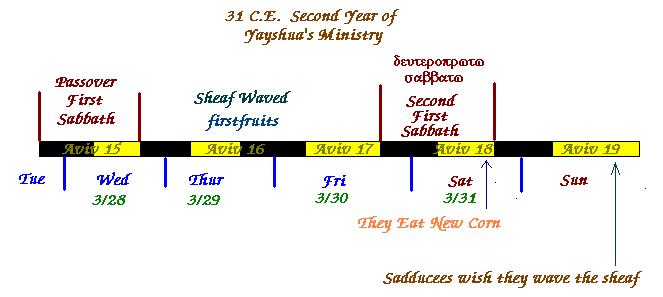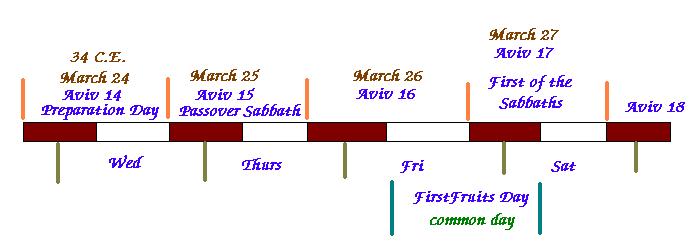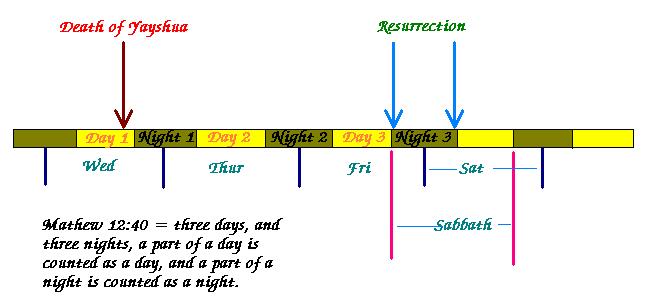Sabbath Resurrection vs. Sunday Resurrection
by Daniel Gregg
Yayshua
our Saviour rose from the dead on the weekly Sabbath,
which was Saturday, March 27th, 34 c.e.
You see the Christian world has been completely deceived by a false translation
of the resurrection passages. Ask yourself a hard question:
Why did the translators switch from the word "sabbath" to the word "week"
in Matthew 28:1: "In the end of the Sabbath, at dawn on the first day of
the week ...", when the Greek word is the same in both cases? That
word is sabbatwn. It is the common
everyday word in the Bible for "Sabbath." Consider a correct interlinear
translation:
Latter yet of-Sabbaths at-the dawning on first of-sabbaths
Oye de sabbatwn th epifwskoush eiV mian sabbatwn
There is no other conclusion
possible. The translations lie. The Greek tells the truth.
And no matter what you think it means, the translators did bury the idea
of the Sabbath altogether when they translated it "week." Often the
translators make the excuse that the Jews counted days with respect to
the Sabbath. If that is the case here, then why didn't they count
"one day from the Sabbath"? Because, they still don't want the Sabbath
mentioned! At any rate their excuse is invalid. The Jews do
not count days "from the Sabbath." They count days "to the Sabbath,"
and that, my friends, is impossible to get out of the Greek.
There is no way to get around the literal plain sense of the Greek.
It says what it says. Even, if it could be proved that "week" was
a possible rendering of the word sabbatwn, it
still would not be the usual meaning of the word. In fact, it can
be questioned whether the word ever meant "week" at any time. The
only places it is so translated are in the resurrection passages and two
other passages, in which the first Sabbath comes right after Passover!
In any case, if
you are wondering why such a complete deception was foisted upon the Christian
world, I have more bad news, that is related to, but not the subject of
the page, which I will be writing up eventually: The Church
Translators of the New Testament Books have mangled and corrupted the literal
meaning of every important religious word in those books. You
can click here for a list of them. So the saying is true, "Why
should you be beaten anymore? Why do you persist in rebellion?
Your whole head is injured, your whole heart afflicted. From the
sole of your foot to the top of your head there is no soundness" (Isaiah
1:5-6). I will mention the 7000+ times that they also mistranslated
"Yahweh" as "Lord" in the Law and Prophets, defying the divine command
in Exodus 3:15, "Yahweh your Elohim of your fathers, the Elohim of Avraham,
the Elohim of Yistkhaq, and the Elohim of Ya'akov has sent me to you, THIS
IS MY NAME FOREVER, the name by which I am to be remembered from generation
to generation." So what can we expect of a generation of scholars
and translators that has blotted out Yahweh's very name? Mark my
words. Yahweh will blot them out when he returns as "Lord of lords,
and king of kings." Every knee will bow, and every tongue will confess
that Yayshua is Yahweh of Hosts.
Now, as I
said, the literal translation of the passage is "On the Latter of the sabbaths,
at the dawning on the first of the Sabbaths ..." So let us explore
this topic. What is the first Sabbath, and what is the later Sabbath.
And how did the later Sabbath come to be called the first? Let us
start with an observation of E.W. Bullinger from the Companion Bible, when
he comments on Luke 6:1, "And it came to pass on the second sabbath after
the first, that He went through the corn fields."
The second sabbath after
the first. All this represents only one word in the Greek (deuteroprwtw),
i.e. the second-first. Occ. only here in the N.T. The first
and second sabbaths can occur only in the week of the three great Feasts.
The first day of these feasts is a Sabbath "high day" (Heb. yom tov
), and is the "first" or great sabbath, whatever day of the week it falls
on (see Lev. 23. 7, 24, 35), the weekly sabbath then becomes the "second".
This "second sabbath" was therefore the ordinary weekly sabbath,
as is clear from Matt. 12.1. Not seeing this the current Greek texts
solve the difficulty by ommiting the word altogether! L. Trm. WH R.
Now the first day of Unleavened
bread was called "The Sabbath" by the Jews (Lev. 23:11). And since
it was the first high holy day, it was called the first Sabbath.
I must urge you not to let the Church, the Samaritans or the Sadducees
confuse you on this point. They all refuse to heed the historical
record that Lev. 23:11 speaks of the festival Sabbath --- a fact documented
in Josephus, Philo, the Targums, the Rabbis, the LXX, and by the Pharisees,
who were endorsed by Yayshua himself as the legitimate interpreters of
Torah (Mt. 23:1-3). The following weekly Sabbath was called the second
sabbath, or as we have it in Mt. 28:1, the "Latter Sabbath." Now
I will summon two more witnesses: The first is the Concordant Version
Commentary, written by A.E. Knoch. He comments on Luke 6:1:
The somewhat enigmatical
word second-first in the Greek has proved so inexplicable that many
texts have omitted it, and few editors retain it. Many explanations
have been offered, but most of them are base on conjecture. The solution
seems simple. The Jews had several sabbaths besides the seventh day
of the week. The fifteenth and the twenty-first of Nisan were sabbaths,
being the first and last days of the festival of Unleavened Breads.
When the weekly sabbath came on the sixteenth, two sabbaths would come
together, one a "great day" (Jn. 1931), and the next an ordinary
sabbath. To distinguish the fifteenth ... sabbath from the double
sabbath a week later it was called the first, and to distinguish the second
day form the first it was called the second-first (Lev. 23.6-8).
This was probably the day of His resurrection" (pg. 99; Luke 6:1, Concordant
Commentary on the New Testament).

So, the 15th, the first day
of unleavened bread, the first rest day of the feast, was called "The first
Sabbath," and the following weekly Sabbath was called the "second-first"
Sabbath. So we have two 'first' Sabbaths, the former being the feast
day, and the latter of these Sabbaths being the weekly Sabbath (see
figure). Now, will the next witness please enter. What additional
reason was there for calling the weekly Sabbath, the "first of the Sabbaths"?
Johnston M. Cheney exposits on this mystery, while proving that Yayshua's
ministry lasted at least 4 years (4 1/2 to be exact 30 c.e. to 34 c.e.):
The second Passover alluded
to: There is a reference, however, to the second Passover; but it
is not given by John. Luke speaks of an early harvest event in Chapter
6, in which he gives an oblique reference to a second Passover, just
after Jesus had called the Twelve for full-time discipleship (Sec. 36).
On that occasion Jesus and His disciples were condemned for eating grain
in the harvest field on a sabbath. This springtime event was obviously
between the first and third Passovers, as evidenced in all three Synoptics.
But further evidence of it being the second Passover is provided in a curious
rendering of Luke 6:1, which has been all but lost in translations.
The reason for its being lost was probably that it was altered by an early
scribe who totally misunderstood its meaning. The phrase in question
is, "the second First Sabbath," whis footnoted in the United Bible Society's
new Greek text as having strong support win the Western and Byzantine Texts.
The reading giving in Sec. 36 of THE LIFE OF CHRIST IN STEREO is:
And it came to pass on
the second First Sabbath that he was walking through the grain fields ....
What is the meaning of
"the second First Sabbath?" A clue to its probable meaning is found
in Leviticus 23:15-21, where directions for setting the date of Pentecost
are given. Seven sabbaths were to be counted from the Feast of First-fruits
or Passover. Consequently, these came to be known as "First Sabbath,"
"Second Sabbath" etc., down to the seventh. And according to Julian
Morgenstern, former President of Hebrew University, this practice continued
in Galilee till the time of Christ or the Common Era. It is still
observed by some groups in Palestine today. Thus, there was an annual
date known as "First Sabbath," just after Passover. And Luke, the
careful historian, records that this event in the grain fields took place
on the "second First Sabbath" .... This, then pin-points the occasion of
the second Passover and indicates the completion of the first year of His
public ministry.
So, now we can begin to understand
Matthew 28:1, "On the latter of the Sabbaths,
at the dawning on the first day of the Sabbaths,
Miryam of Migdol and the other Miryam came to view the grave." (cf.
also Mark 16:1-2; Luke 23:56-24:1;
John 20:1, 19). The weekly Sabbath
of Passover week was both the latter sabbath (see diagram)
with respect to the first sabbath day of unleavened bread, and also the
first of the sabbaths in a seven sabbath count leading up to Pentecost
(see diagram). In terms of the year of Yayshua's
death and resurrection, the 25th of March was the Passover Sabbath, and
the 27th of March was the weekly Sabbath, hence the designation "Latter"
given by Matthew.
Now in the week of Yayshua's death and Resurrection there were two Sabbaths,
which were the first day of Passover and the regular Sabbath. These
fell on March 25th, and March 27th in 34 c.e. The former Sabbath
of the week is the Passover Sabbath, and the "latter
of the Sabbaths" is the regular Sabbath.

This
"latter of the Sabbaths"
with respect to Passover week, is also called "the first of
the Sabbaths" with respect to the feast of Penteocst: For it
is written:
"And
you shall count from the day after the Sabbath, from the day that you brought
the sheaf of the wave offering, seven Sabbaths
complete shall be; Meanwhile from the day
after the seventh Sabbath, continue counting the fifty days." (Lev. 23:15-16).
So seven Sabbaths are to be counted between Passover and Pentecost while
also fifty days are to be counted between the same.
So, the weekly sabbaths would be enumerated, "the first of
the sabbaths," "the second of the sabbaths"
... "the seventh of the sabbaths."
So the Resurrection was on the first of these.

.
Now it is clear that the women arrived in the morning while it was
still dark (cf. John 20:1), or while still "deep
dawn" (Luke 24:1) as the sun was coming up (cf.
Mark 16:2). There is only one morning on the Sabbath day which
they could arrive at, and that is before dawn on the Sabbath, not after
the Sabbath on Sunday. For we just showed that they came "on the
first of the Sabbaths" (also called "the latter
of the Sabbaths"). Therefore, the resurrection occured in the night
part of the Sabbath (Friday sunset to Saturday sunrise). All, the
resurrection appearances occured on the Sabbath day.
Now it is established beyond all doubt that "first of
the Sabbaths" in the resurrection passages means the Sabbath day
by usage, grammar, and parallel examples.
We can then proceed to demonstrate how the Sabbath Resurrection is able
to harmonize the entire chronology of the scripture, and that it
does not in any way contradict Torah.
The Sabbath Resurrection explains Matthew 12:40, where it says that Yayshua
would be in the grave "three days and three nights." The days are
(1) part of Wed, (2) Thur, (3) Fri, and the nights are (1) Wed night, (2)
Thur night, and (3) part of Fri night (see diagram):

The Sabbath Resurrection also explains those passages that say Yeshua would
rise "after three days" (Mark 8:31; Mark 9:31). When the sun set
on Wed, it was "after one day," and when the sun set on Thur., it was "after
two days," and when the sun set on Fri., it was "after three days" (and
note this:) it remained "after three days" until sunset ending the Sabbath.
The "after three day" passages create fatal problems for the Friday-Sunday
senario. See diagram.
The Sabbath Resurrection even explains those passages which say he would
rise "on the third day" (1 Cor. 15:4, etc, See Figure).
In this case, the day must be reckoned from sunrise as in Lev. 23:32 for
the day of Atonement. The first day is sunrise Wed. to sunrise Thur..
The second day is sunrise Thur to sunrise Fri. And the third day
is sunrise Fri to sunrise Sabbath. But note this: the resurrection
was before sunrise on the Sabbath, which was still the third day by sunrise
reckoning.
.
The Sabbath Resurrection explains why Matthew alludes to two Sabbaths ("the
latter of the Sabbaths"), and why Mark mentions
two Sabbaths ("passing the sabbath ... but on the first of the sabbaths"),
and also why Luke mentions two Sabbaths ("On the one sabbath they rested
..., but on the first day of the sabbaths ..."), and also why John
makes note of the high Sabbath (John 19:31).
The Sabbath Resurrection also explains why "first day of the sabbaths"
only occurs after Passover just before Pentecost (including in Acts 20:7,
and I Cor. 16:2).
The Sabbath Resurrection is confirmed
by astronomy in 34 c.e.
The Sabbath Resurrection explains Daniel's
Prophecy of "Seventy Sevens," which are broken down into "seven sevens"
and "sixty two sevens" and "one period of seven." (Dan. 9:24-27).
A "seven" is a sabbatical year as is proved in Deut. 15:9. Exactly
sixty nine Sabbatical years will fit between 445 b.c.e., when the decree
to rebuild the city was given, and 34 c.e. when the Messiah was cut off,
so that he died.
Only the Sabbath Resurrection can explain
Daniel's prophecy without either tampering with history as we have received
it from the Persians and Romans or by introducing ridiculous assumptions
into the biblical calendar such as the so called 360 day prophetic year.
The Sabbath Resurrection provides
adequate time for Yayshua's ministry. It harmonizes with the 3 b.c.e.
birth of Yeshua on the feast of trumpets, and the sign of Rev. 12:1-3.
It proves and demonstrates the traditional Jewish rule that the new
moon of Aviv is always the one nearest to the equinox. It also proves
and demonstrates that the new moon is at the first visible crescent.
The Sabbath Resurrection proves
that the Pharisees were right on how to count to Pentecost, and that the
Sadducees were wrong.
The Sabbath Resurrection establishes
which year is the sabbatical year, and provides the critical link to establish
which year is the year of Jubilee.
All Rights Reserved.
Send us email.
www.parsimony.org



